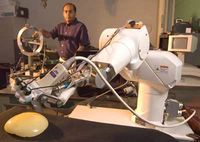Robotic Breast Exams
developing robotic arm capable of doing breast exams
by Tom Oswald
Women living in remote areas who don’t have easy access to health care will someday be able to have a potentially life-saving breast exam thanks to robotic technology being developed at MSU.
Physicians from MSU’s Department of Surgery are teaming with researchers in the College of Engineering to develop a robotic device that can check for lumps and other abnormalities in a woman’s breast and, at the same time, get an ultrasound image.
Here’s how it will work: A physician or other health-care provider, located in a hospital or clinic, will slip his or her hand into a glove-like instrument. That will allow him or her to move the robotic arm that is with the patient in a remote location.

“That arm, which actually looks like a hand, is equipped with sensors,” said Carol Slomski, chairperson of MSU’s Department of Surgery and co-director of the project. “As the hand touches the patient, the sensation from this touch comes back into my hand. When the robotic fingers feel a lump or some other abnormality, I also feel it.”
“Often the ultrasound and exam are done separately. But if the physician can look at the image and feel what he or she is seeing, it’s a huge advantage.”
Slomski said that with a potential shortage of surgeons looming, especially those located in more remote areas, technology such as this will make life easier for both patient and health-care provider.
MSU Today
by Tom Oswald
Women living in remote areas who don’t have easy access to health care will someday be able to have a potentially life-saving breast exam thanks to robotic technology being developed at MSU.
Physicians from MSU’s Department of Surgery are teaming with researchers in the College of Engineering to develop a robotic device that can check for lumps and other abnormalities in a woman’s breast and, at the same time, get an ultrasound image.
Here’s how it will work: A physician or other health-care provider, located in a hospital or clinic, will slip his or her hand into a glove-like instrument. That will allow him or her to move the robotic arm that is with the patient in a remote location.

“That arm, which actually looks like a hand, is equipped with sensors,” said Carol Slomski, chairperson of MSU’s Department of Surgery and co-director of the project. “As the hand touches the patient, the sensation from this touch comes back into my hand. When the robotic fingers feel a lump or some other abnormality, I also feel it.”
“Often the ultrasound and exam are done separately. But if the physician can look at the image and feel what he or she is seeing, it’s a huge advantage.”
Slomski said that with a potential shortage of surgeons looming, especially those located in more remote areas, technology such as this will make life easier for both patient and health-care provider.
MSU Today
Labels: healthcare robot, telepresence

0 Comments:
Post a Comment
Subscribe to Post Comments [Atom]
<< Home